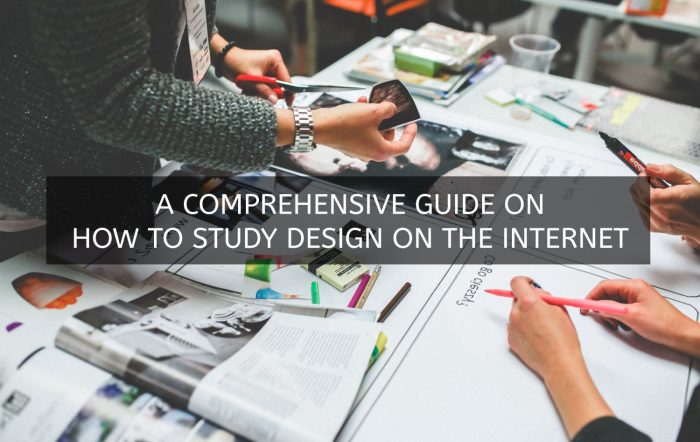A Comprehensive Guide on How to Study Design on the Internet
The internet has transformed the way we access information and acquire new skills, and design is no exception. Whether you’re a beginner seeking to explore the world of design or a seasoned practitioner looking to expand your skill set, the vast resources available online provide an excellent avenue for study. In this comprehensive guide, we’ll navigate the digital landscape together, outlining effective strategies to study design on the internet and enhance your creative journey.
1. Establish Clear Learning Objectives:
Before diving into the myriad of online resources, define your learning objectives. Whether you’re interested in graphic design, web design, or UX/UI design, having a clear vision of your goals will guide your study plan. Outline the specific skills you want to acquire and the projects you’d like to undertake, creating a roadmap for your design education
2. Explore Online Courses and Platforms:
Numerous online platforms offer comprehensive design courses taught by industry professionals. Websites like Coursera, Udemy, and Skillshare provide a variety of design courses for all skill levels. Explore the curriculum, reviews, and instructor profiles to find courses that align with your learning style and objectives. Many platforms offer a combination of video lectures, assignments, and forums for interactive learning.
3. Engage with Design Communities:
Joining online design communities is a fantastic way to connect with fellow learners and experienced designers. Platforms like Behance, Dribbble, and Reddit’s design-related subreddits provide spaces for sharing work, seeking feedback, and participating in discussions. Engaging with a community not only expands your network but also exposes you to diverse perspectives and approaches in the design field.
4. Leverage Design Blogs and Websites:
Design blogs and websites offer a wealth of articles, tutorials, and inspiration. Follow reputable design blogs like Smashing Magazine, Awwwards, or Creative Bloq for articles on design principles, industry trends, and tutorials. Subscribe to newsletters and set aside time regularly to explore these resources, staying informed about the latest developments in the design world.
5. Utilize Online Design Tools:
Practical application is a crucial aspect of learning design. Familiarize yourself with online design tools that facilitate hands-on practice. Platforms like Figma, Canva, and Adobe Spark offer user-friendly interfaces for creating graphics, prototypes, and layouts. Experiment with these tools to reinforce theoretical concepts and build a practical skill set.
6. Watch Design Video Tutorials:
Video tutorials provide a dynamic and visual way to learn design techniques. Platforms like YouTube host a plethora of design tutorial channels, covering topics from software tutorials to design theory. Seek out tutorials from reputable creators, follow step-by-step instructions, and pause or rewind as needed to reinforce your understanding.
7. Enroll in Design Bootcamps:
For a more immersive and structured learning experience, consider enrolling in design bootcamps. Bootcamps like General Assembly, Ironhack, or Designlab offer intensive, hands-on programs with mentorship and project-based learning. While some bootcamps are paid, many offer scholarships or flexible payment options, making them accessible to a wide range of learners.
8. Read Design Books and eBooks:
Books remain a timeless source of knowledge. Invest time in reading design books and eBooks that cover a spectrum of topics, from design theory to case studies and practical guides. Look for titles recommended by industry professionals or explore bestseller lists in design categories for well-reviewed options.
9. Participate in Online Design Challenges:
Design challenges are an effective way to apply your skills to real-world scenarios. Platforms like 99designs, Adobe Creative Jam, or Design Challenges on Behance provide opportunities to test your creativity, receive feedback, and build a diverse portfolio. Engaging in challenges adds a practical dimension to your learning journey.
10. Create a Personal Design Project:
Hands-on experience is invaluable in design education. Initiate a personal design project that aligns with your interests and goals. It could be redesigning a website, creating a branding package, or developing a mobile app interface. Document your process, challenges, and solutions, turning your project into a showcase of your evolving skills.
11. Follow Industry Influencers on Social Media:
Social media platforms like Instagram, Twitter, and LinkedIn are hubs for design inspiration and industry insights. Follow influential designers, studios, and design-related accounts to stay updated on the latest trends, discover new techniques, and gain valuable insights into the design community.
12. Attend Virtual Design Conferences and Webinars:
While physical conferences may not always be feasible, virtual design conferences and webinars offer opportunities to learn from industry experts. Keep an eye on events hosted by organizations like AIGA, UX Design Institute, or Adobe MAX. Participating in live sessions allows you to engage with speakers, ask questions, and stay connected with the broader design community.
Studying design on the internet is a dynamic and empowering endeavor. By strategically navigating online courses, engaging with communities, and embracing practical applications, you can cultivate a robust foundation in design. Remember that the design field is continually evolving, and the internet provides a vast playground for exploration and growth. As you embark on your design education journey, celebrate the process, stay curious, and let the digital canvas be your guide to unlocking the boundless possibilities of creativity.
However, if you don’t want to study design by yourself you always can rely on people who are experts in this field. For example you can visit this design studio from the internet. They are very professional in design and graphics. And maybe it will be a better decision to invest your money in their services than in studying everything from scratch.




















































